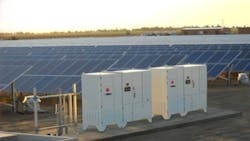Ride Through Any Storm
When PG&E set out a five-year plan to enable 250 MW of utility-owned solar power in an effort to speed up the delivery of more solar energy to its customers, the company was faced with the challenge of selecting the right utility-scale PV inverters. Decision-makers at PG&E needed to be able to ensure that the inverters they chose would make it possible to achieve high energy-efficiency ratings, low Levelized Cost of Energy (LCOE), and ultimately mitigate any intermittency issues that could arise.
Starting with the Central Valley, an area that holds incredible potential as a source of solar energy for California, PG&E chose to install utility-scale PV inverters from Advanced Energy for the first phase of its five-year plan at two project sites, Stroud and Westside. These particular inverters provide low voltage ride through (LVRT) and reactive power control which, as PG&E would soon realize, proved to be the most cost-effective decision.
Voltage Ride Through (VRT) timing profiles in inverters provide the inverter with the ability to help stabilize the grid and meet the interconnection requirements of the California Independent System Operator Corporation (CAISO). The VRT utility timing rules are counter to the Anti-Islanding timing rules of IEEE 1547 which forces the inverters to drop offline during low voltage sag events and to stay offline for a minimum of 5 minutes.
In February 2012, a feeder at one of the sites experienced a short circuit condition causing both A and B phases at the connected substation to experience a 50% voltage sag which activated the inverters’ LVRT capabilities. The relays on the line detected the event, and cleared the fault in approximately 7 cycles. After collecting the Schweitzer Engineering Laboratories (SEL) graphs, it was evident that the inverters successfully rode through the event and returned to normal operation upon clearance of the short circuit condition.
The following month, a total of four low-voltage events occurred at PG&E’s Shindler substation, outside of Fresno, CA. These events were caused by momentary phase to phase faults on the circuit at the substation. Scope traces from the Westside Solar Station showed close to a 50% voltage depression at the 12 kV bus for approximately 5 cycles during each of these events with the inverters between 20% and 80% of full power. Despite all of these interferences, the inverters at both sites remained online, in large part due to the LVRT capability of the utility inverters PG&E has chosen to install.
To further demonstrate these events, Figure 1 shows where the current temporarily went up for about 2 cycles at the inception of the faults. This is expected behavior as the inverters are operating at less than 50% of nameplate. When the line voltage began to drop the inverters attempted to maintain a constant output power and the AC current increased up to its limit before the LVRT features were activated.
VRT enabled inverters manage to stay online during grid disturbances and produce reactive power in an effort to stabilize the grid. As part of the VRT offering, some inverters can perform Zero Voltage Ride Through (ZVRT), High Voltage Ride Through (HVRT) and LVRT. Because of the VRT capabilities, the inverters were able to ride through multiple disturbance events which enabled the generation station to stay online, ultimately limiting the revenue lost to the investors while contributing to grid stabilization. This also allows PG&E to follow the utility required timing profile and quickly ramp back up after an event has cleared.
These events successfully demonstrated the importance of LVRT capabilities in utility PV inverters. The Solar Stations graphs provide data that has allowed the team at PG&E to better understand the impacts of inverters with LVRT capabilities to support the grid in areas with a high penetration of distributed generation.
Now in its second year of implementation, PG&E is well on its way to meeting all of the goals that were laid out in the original five-year plan, in large part because of the proven reliability of their AE inverters with LVRT capabilities.
